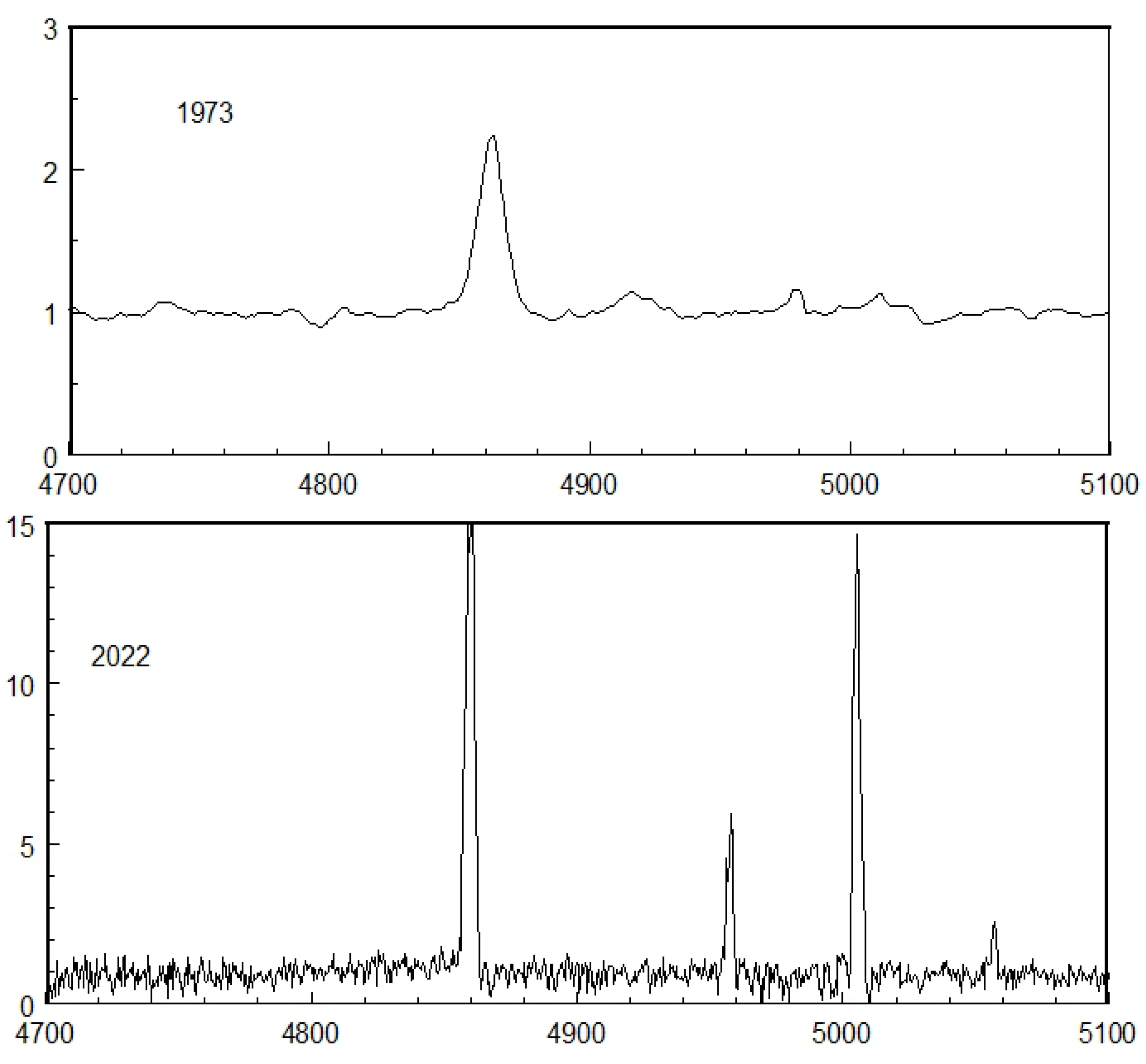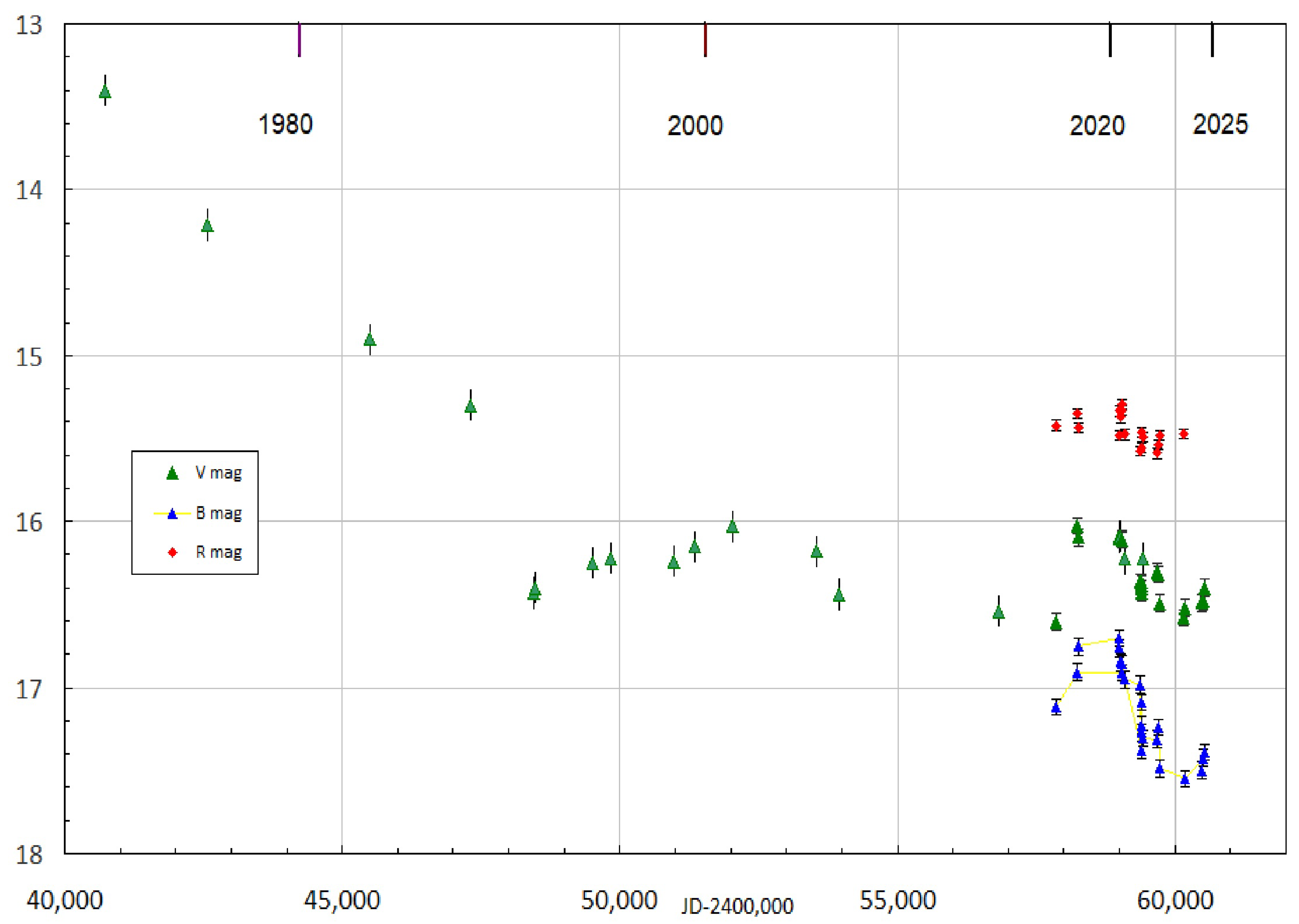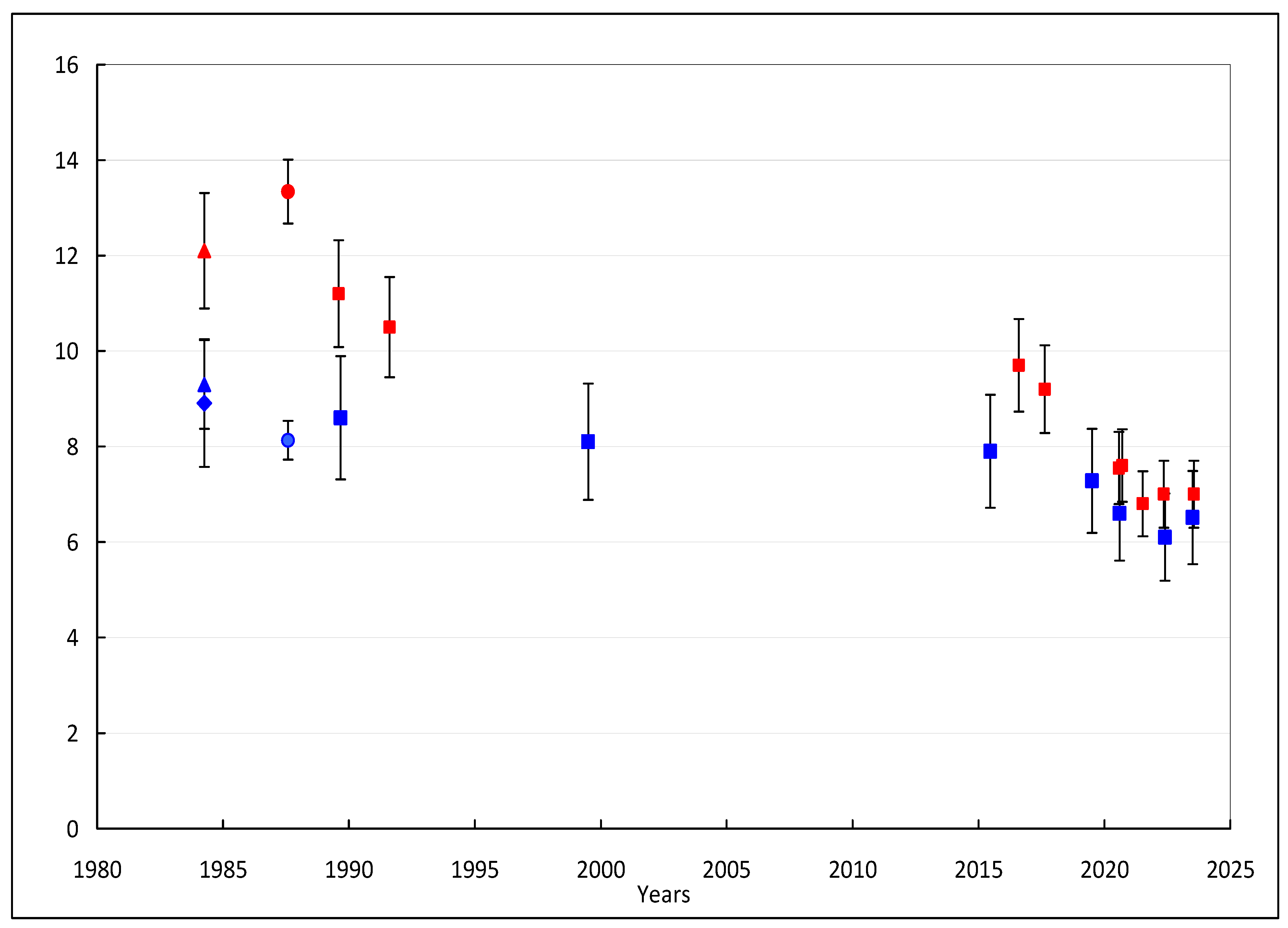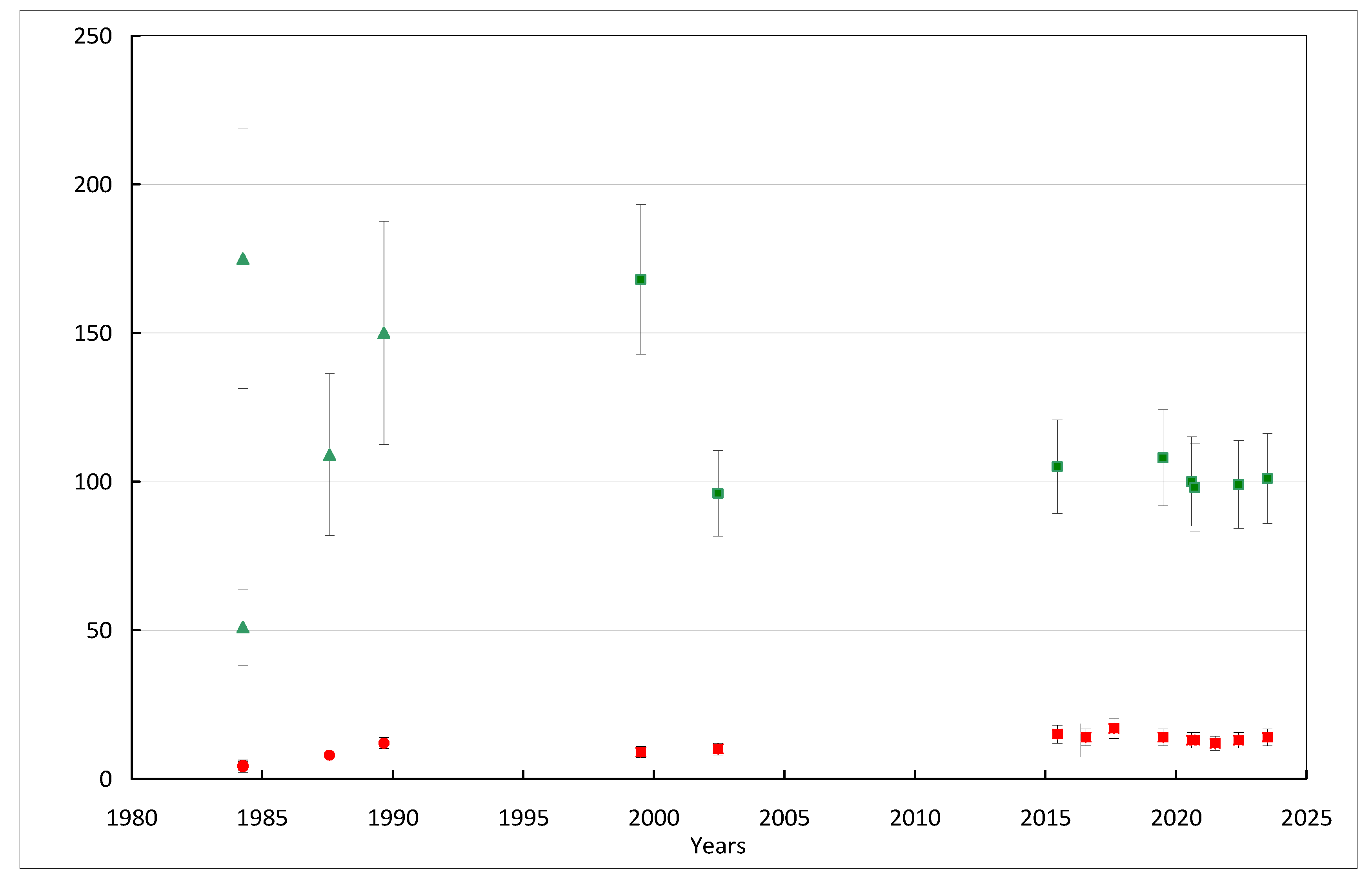Three Stages in Evolution of the Object Th4-4
Abstract
:1. Introduction
2. Equipment and Methods of Observation
3. Results
4. Discussion
5. Conclusions
Author Contributions
Funding
Data Availability Statement
Conflicts of Interest
References
- Iłkiewicz, K.; Mikołajewska, J.; Scaringi, S.; Teyssier, F.; Stoyanov, K.; Fratta, M. SU Lyn-a transient symbiotic star. Mon. Not. R. Astron. Soc. 2022, 510, 2707. [Google Scholar] [CrossRef]
- Murset, U.; Dumm, T.; Isenegger, S.; Nussbaumer, H.; Schild, H.; Schmid, H.M.; Schmutz, W. High resolution spectroscopy of symbiotic stars⋆ V. Orbital and stellar parameters for FG Ser (AS296). Astron. Astrophys. 2000, 353, 952. [Google Scholar]
- Leedjavr, L.; Mikolajewski, M. The peculiar symbiotic star CH Cygni: Variability and nature of the hot component. ASP Conf. Ser. 2000, 204, 351. [Google Scholar]
- Dumm, T.; Murset, M.; Nussbaumer, H.; Schild, H.; Schmid, H.M.; Schmutz, W.; Shore, S.N. High resolution spectroscopy of symbiotic stars⋆ IV. BX Monocerotis: Orbital and stellar parameters. Astron. Astrophys. 1998, 336, 637. [Google Scholar]
- Kohoutek, L. VizeR Online Data Catalog: New and Misclassified Panetary Nebuae. Astron. Nachrichten 1997, 318, 35. [Google Scholar] [CrossRef]
- Zijlstra, A.; Pottasch, S.; Bignell, C. Misclassified planetary nebulae. Astron. Astrophys. Suppl. Ser. 1990, 82, 273. [Google Scholar]
- Acker, A. Planetary nebula: Phenomenon or object? Some classificatiion probles. In Comptes Rendus sur les Journees de Strasbourg; Observatoire de Strasbourg: Strasbourg, France, 1986; Volume 8, pp. 1–23. [Google Scholar]
- Denissyuk, E.K. Spectrograph for Faint Objects: The Device and the Main Results of Observations. Astron. Astrophys. Trans. 2003, 22, 175–189. [Google Scholar] [CrossRef]
- Kharitonov, A.; Tereschenko, V.; Knyzeva, L. Spectrophotometric Catalog of Stars; Almaty, Kazakh University: Almaty, Republic of Kazakhstan, 2011. [Google Scholar]
- Kondratjeva, L. Spectroscopic and photometric variability of the planetary nebula Th 4-4. Sov. Astron. Lett. 1989, 15, 29–32. [Google Scholar]
- Landolt, A. UBVRI Photometric Standard Stars around the Sky at +50 deg Declination. Astron. J. 2013, 146, 131. [Google Scholar] [CrossRef]
- The, P.S. Eleven New Planetary Nebulae; Contr. from the Bosscha Observ. Lembang: Lembang, Indonesia, 1964; Volume 28. [Google Scholar]
- Perek, L.; Kohoutek, L. Catalogue of Galactic Planetary Nebulae; Publication House Czechoslovak Academy of Sciences: Prague, Czech Republic, 1967. [Google Scholar]
- Bracewell, R. Simple Graphical Method of Correcting for Instrumental Broadening. J. Opt. Soc. Am. 1955, 45, 873. [Google Scholar] [CrossRef]
- Kondrat’eva, L. Two emission objects with the broad emission lines. Tr. Astrofiz. Inst. 1975, 25, 23. [Google Scholar]
- Allen, D.; Swings, J. The spectra of peculiar Be stars with infrared excesses. Astron. Astrophys. 1976, 47, 293–302. [Google Scholar]
- Acker, A.; Raytchev, B.; Koeppen, J.; Stenholm, B. An extensive study of planetary nebulae in the galactic bulge. I. Spectrophotometric data. Astron. Astrophys. Suppl. Ser. 1991, 89, 237. [Google Scholar]
- Allen, D. A Catalogue of symbiotic stars. Proc. Astron Soc. Aust. 1984, 5, 369–384. [Google Scholar] [CrossRef]
- Mikolajewska, J.; Acker, A.; Stenholm, B. Spectrophotoetric study of southern symbiotic stars. Astron. Astrophys. 1997, 327, 191–198. [Google Scholar]
- Belczynski, K.; Mikolajewska, J.; Munari, U.; Ivison, R.J.; Friedjung, M. Catalogue of symbiotic stars. Astron. Astrophys. Suppl. Ser. 2000, 146, 407. [Google Scholar] [CrossRef]
- Kondrat’eva, L. Rapid evolutionary changes in the spectrum of Th4-4. Astron. Lett. 1993, 39, 330. [Google Scholar]
- Gutierrez-Moreno, A.; Moreno, H.; Corrtes, G. Observations of Five Suspected Symbiotic stars. Publ. Astron. Soc. Pac. 1992, 104, 1187–1992. [Google Scholar] [CrossRef]
- Luna, G.; Costa, R.L. Nebular abundances of southern symbiotic stars. Astron. Astrophys. 2005, 435, 1087–1097. [Google Scholar] [CrossRef]
- Brocklehurst, M. Calculation of level populations or the low levels of hydrogenic ions in gaseous nebulae. Mon. Not. R. Astron. Soc. 1971, 153, 471. [Google Scholar] [CrossRef]
- Netzer, H. Physical conditions in active nuclei-I. The Balmer decrement. Mon. Not. R. Astron. Soc. 1975, 171, 395. [Google Scholar] [CrossRef]
- Dong, X.; Wang, T.; Wang, J.; Yuan, W.; Zhou, H.; Dai Hand Kai Zhang, K. Broad-line Balmer decrements in blue active galactic nuclei. Mon. Not. R. Astron. Soc. 2008, 383, 581. [Google Scholar] [CrossRef]
- Guo, H.L.; Chen, B.Q.; Yuan, H.B.; Huang, Y.; Liu, D.Z.; Yang, Y.; Liu, X.W. Three-dimensional Distribution of the Interstellar Dust in the Milky Way. Astrophys. J. 2021, 906, 47. [Google Scholar] [CrossRef]
- Mowlavi, N.; Lecoeur-Taibi, I.; Lebzelter, T.; Rimoldin, L.; Lorenz, D.; Audard, M.; De Ridder, J.; Eyer, L.; Guy, L.P.; Holl, B. Gaia Data Release 2. The first Gaia catalogue of long-period variable candidates. Astron. Astrophys. 2018, 618A, 58. [Google Scholar] [CrossRef]
- Vogel, M.; Nussbaumer, H. PU Vulpeculae : The outburst of a symbiotic nova. Astron. Astrophys. 1992, 259, 525. [Google Scholar]
- C’uneo, V.; Kenyon, S.; G’omez, M.; Chochol, D.; Shugarov, S.; Kolotilov, E. An illumination effect and eccentric orbit for symbiotic binary PU Vul revealed by 32 yr of optical spectroscopy. Mon. Not. R. Astron. Soc. 2018, 479, 2728. [Google Scholar]




| Date | JD-2400000 | B | V | R |
|---|---|---|---|---|
| 1964 [12] | - | - | 13.7 ± 0.05 | |
| May 1970 | 40,721.00 | - | 13.40 ± 0.10 | - |
| June 1975 | 42,578.00 | - | 14.20 ± 0.10 | - |
| June 1983 | 45,500.00 | - | 14.90 ± 0.10 | - |
| 1984 [18] | 17.5 ± 0.05 | - | 15.63 ± 0.05 | |
| July 1988 | 47,327.00 | - | 15.30 ± 0.10 | - |
| July 1991 | 48,452.00 | - | 16.43 ± 0.10 | - |
| August 1991 | 48,483.00 | - | 16.40 ± 0.10 | - |
| July 1994 | 49,518.00 | - | 16.25 ± 0.10 | - |
| May 1995 | 49,852.00 | - | 16.22 ± 0.10 | - |
| July 1998 | 50,979.00 | - | 16.24 ± 0.10 | - |
| June 1999 | 51,344.00 | - | 16.15 ± 0.10 | - |
| May 2001 | 52,045.42 | - | 16.03 ± 0.10 | - |
| June 2005 | 53,567.42 | - | 16.18 ± 0.10 | - |
| 29 June 2006 | 53,946.25 | - | 16.44 ± 0.10 | - |
| 25 June 2014 | 56,834.22 | - | 16.54 ± 0.10 | - |
| 24 April 2017 | 57,868.43 | 17.72 ± 0.04 | 16.60 ± 0.06 | 15.42 ± 0.11 |
| 7 May 2018 | 58,246.45 | 16.91 ± 0.05 | 16.02 ± 0.07 | 15.35 ± 0.11 |
| 5 July 2018 | 58,275.37 | 16.75 ± 0.10 | 16.09 ± 0.04 | 15.43 ± 0.06 |
| 22 May 2020 | 58,992.33 | 16.70 ± 0.14 | 16.10 ± 0.10 | 15.48 ± 0.14 |
| 27 July 2020 | 59,058.21 | 16.85 ± 0.03 | 16.11 ± 0.03 | 15.49 ± 0.10 |
| 7 September 2020 | 59,100.13 | 16.95 ± 0.10 | 16.23 ± 0.10 | 15.48 ± 0.19 |
| 14 June 2021 | 59,380.26 | 16.98 ± 0.06 | 16.37 ± 0.05 | 15.57 ± 0.08 |
| 27 June 2021 | 59,393.21 | 17.38 ± 0.07 | 16.57 ± 0.02 | - |
| 29 June 2021 | 59,395.25 | 17.27 ± 0.04 | 16.40 ± 0.04 | 15.55 ± 0.04 |
| 30 June 2021 | 59,396.22 | 17.09 ± 0.05 | 16.38 ± 0.04 | 15.55 ± 0.07 |
| 8 July 2021 | 59,402.22 | 17.23 ± 0.04 | 16.44 ± 0.04 | 15.46 ± 0.08 |
| 24 July 2021 | 59,420.21 | 17.30 ± 0.05 | 16.40 ± 0.08 | 15.56 ± 0.08 |
| 15 April 2022 | 59,685.43 | 17.31 ± 0.06 | 16.30 ± 0.03 | 15.49 ± 0.08 |
| 8 May 2022 | 59,708.36 | 17.24 ± 0.06 | 16.32 ± 0.04 | 15.79 ± 0.03 |
| 24 August 2022 | 59,735.29 | 17.48 ± 0.01 | 16.49 ± 0.03 | 15.74 ± 0.04 |
| 3 August 2023 | 60,160.24 | 17.54 ± 0.04 | 16.68 ± 0.05 | 15.08 ± 0.09 |
| 16 August 2023 | 60,173.16 | 17.55 ± 0.05 | 16.52 ± 0.03 | 15.27 ± 0.10 |
| 27 June 2024 | 60,489.34 | 17.50 ± 0.02 | 16.42 ± 0.03 | - |
| 12 July 2024 | 60,504.19 | 17.42 ± 0.05 | 16.46 ± 0.04 | - |
| 7 August 2024 | 60,530.16 | 17.19 ± 0.06 | 16.36 ± 0.03 | - |
| Date of Observ. | F(Hβ) erg/cm2 s | I(5007) | F(Hα) erg/cm2 s | I(6678) | I(7065) | References |
|---|---|---|---|---|---|---|
| 30 April 1984 | (8.9 ± 0.6) 10−14 | 175 ± 20 | 300 ± 35 | 4.5 ± 0.6 | 12 ± 1.5 | [17] |
| July 1984 | (9.3 ± 1.3) 10−14 | 51 ± 10 | (12.1 ± 1.8) 10−13 | 4.0 ± 0.8 | 20 ± 3.0 | [19] |
| July 1987 | (8.1 ± 1.0) 10−14 | 109 ± 15 | (13.3 ± 1.3) 10−13 | 7.9 ± 1.0 | 12 ± 1.5 | [22] |
| 8 August 1989 | (8.6 ± 1.3) 10−14 | 150 ± 20 | (11.2 ± 1.8) 10−13 | 12 ± 1.5 | 16 ± 2.0 | AZT-8 |
| 15 April 1999 | (8,1 ± 1.7) 10−14 | 168 ± 20 | 300 ± 35 | 9.2 ± 1.3 | 13 ± 2.0 | AZT-8 |
| 16 June 2002 | - | 96 ± 12 | 300 ± 20 | 10 ± 1.5 | 16 ± 2.0 | [23] |
| 17 June 2015 | (7.8 ± 1.3) 10−14 | 105 ± 15 | - | - | - | AZT-8 |
| 24 June 2016 | - | - | (11.4 ± 1.7) 10−13 | 15 ± 1.7 | - | AZT-8 |
| 18 August 2017 | - | - | (9.2 ± 1.3) 10−13 | 17 ± 2.5 | 20 ± 3.5 | AZT-8 |
| 11 July 2019 | (7,3 ± 1.1) 10−14 | 108 ± 14 | 300 ± 20 | 14 ± 2.0 | 18 ± 2.5 | AZT-8 |
| 13 September 2020 | (6.6 ± 1.1) 10−14 | 100 ± 15 | (7.6 ± 1.2) 10−13 | 13 ± 1.8 | 22 ± 3.0 | AZT-20 |
| 29 June 2021 | - | - | (6.6 ± 1.0) 10−13 | 12 ± 2.0 | 20 ± 3.0 | AZT-8 |
| 29 June 2022 | (6.1 ± 1.2) 10−14 | 99 ± 15 | (7.1 ± 0.9) 10−13 | 12 ± 1.8 | 18 ± 2.2 | AZT-8 |
| 11 July 2023 | (6.5 ± 1.0) 10−14 | 101 ± 15 | (6.7 ± 0.9) 10−13 | 13 ± 2.0 | 18 ± 2.6 | AZT-20 |
| 7 August 2024 | - | - | (8.1 ± 1.6) 10−13 | 14 ± 2.2 | 20 ± 3.0 | AZT-8 |
Disclaimer/Publisher’s Note: The statements, opinions and data contained in all publications are solely those of the individual author(s) and contributor(s) and not of MDPI and/or the editor(s). MDPI and/or the editor(s) disclaim responsibility for any injury to people or property resulting from any ideas, methods, instructions or products referred to in the content. |
© 2025 by the authors. Licensee MDPI, Basel, Switzerland. This article is an open access article distributed under the terms and conditions of the Creative Commons Attribution (CC BY) license (https://creativecommons.org/licenses/by/4.0/).
Share and Cite
Kondratyeva, L.; Denissyuk, E.; Shomshekova, S.; Reva, I.; Aimanova, G.; Krugov, M. Three Stages in Evolution of the Object Th4-4. Galaxies 2025, 13, 5. https://doi.org/10.3390/galaxies13010005
Kondratyeva L, Denissyuk E, Shomshekova S, Reva I, Aimanova G, Krugov M. Three Stages in Evolution of the Object Th4-4. Galaxies. 2025; 13(1):5. https://doi.org/10.3390/galaxies13010005
Chicago/Turabian StyleKondratyeva, Lyudmila, Eduard Denissyuk, Saule Shomshekova, Inna Reva, Gauhar Aimanova, and Maxim Krugov. 2025. "Three Stages in Evolution of the Object Th4-4" Galaxies 13, no. 1: 5. https://doi.org/10.3390/galaxies13010005
APA StyleKondratyeva, L., Denissyuk, E., Shomshekova, S., Reva, I., Aimanova, G., & Krugov, M. (2025). Three Stages in Evolution of the Object Th4-4. Galaxies, 13(1), 5. https://doi.org/10.3390/galaxies13010005






